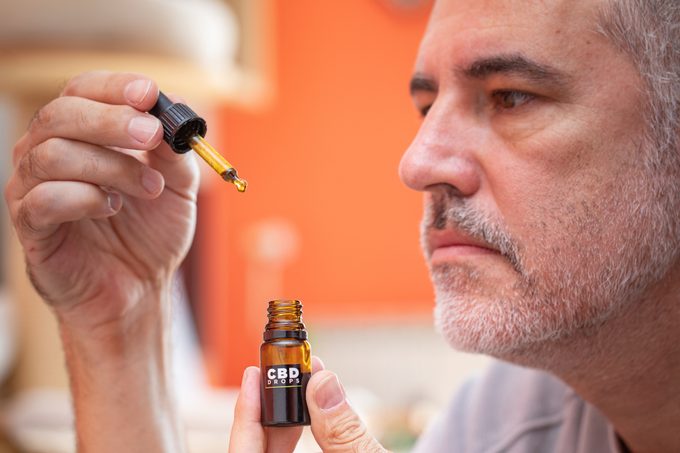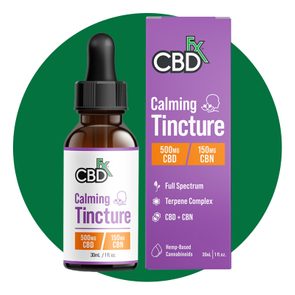What to Know About Using CBD for Migraines
Updated: Apr. 29, 2021
Taking CBD may help prevent migraines, while topical CBD oil may ease pain that accompanies these headaches. Here's what you need to know.
Managing migraines
If you get migraines, you’ve likely looked for all kinds of treatments to ease your headache pain. Along with pain medication, migraine home remedies, and lifestyle changes, you might have considered CBD for migraines.
If you don’t experience migraines, you likely know someone who does. Nearly one in four U.S. households includes someone who gets them, according to the Migraine Research Foundation. They are more than just headaches, and can cause debilitating head pain, along with nausea, vomiting, and extreme sensitivity to light and nose.
These throbbing, usually one-sided episodes of pain tend to have an outsize impact on women—although anyone can get them. In a 2018 survey by the Centers for Disease Control and Prevention, more than one in five women reported having a severe migraine in the previous three months. Younger adults were the hardest hit, with one-quarter of 18- to 44-year-old females reporting a recent severe migraine.
Migraines are about half as common in men, with 10.6 percent reporting a severe headache in the past three months. And they affect about 10 percent of school-age kids and more than a quarter of 15- to 18-year-olds.
Despite being so common, migraines are often underdiagnosed and undertreated, the foundation notes, with the “vast majority” of people with migraines—known as migraineurs—never seeking medical treatment, and over half never being diagnosed.
Can CBD help with migraine?
Multiple laboratory and animal studies support the potential use of cannabis and its components, including cannabidiol (CBD), for migraine pain, according to a study published in 2018 in the Journal of Headache and Pain.
In a survey of over 2,000 medical cannabis patients, the authors found one-quarter were using marijuana for headache or migraine. These patients reported that one Cannabis sativa strain or chemovar, “OG Shark,” was particularly helpful. This strain contains relatively high levels of delta-9-tetrahydrocannabinol (THC)—the main mind-altering chemical found in marijuana—and low levels of CBD, along with the terpenes beta carophyllene and beta myrcene.
“The studies clearly show that CBD is an anti-inflammatory,” notes Bonni Goldstein, MD, medical director and owner of Cannacenters, a medical practice in Los Angeles, and author of Cannabis is Medicine: How Medical Cannabis and CBD are Healing Everything from Anxiety to Chronic Pain. “It’s neuroprotective, meaning it protects your nervous system.”
Dr. Goldstein and other experts believe that CBD may also help with pain by supporting the endocannabinoid system, or ECS. We produce neurotransmitters known as endocannabinoids that interact with cell receptors throughout the body. This forms a feedback loop that’s involved in regulating virtually every system in the body, and can modulate pain perception, mood, appetite, inflammation, and more. Plant cannabinoids, like THC and CBD, interact with the ECS in ways that are still being investigated.
Ethan Russo, MD, a leading medical cannabis researcher, first proposed in 2001 that endocannabinoid deficiency could contribute to migraine, fibromyalgia, irritable bowel syndrome, and similar tough-to-treat, chronic pain conditions.
Based on this idea, treatment with cannabinoids could restore ECS function—also called endocannabinoid “tone”—and help reduce migraines. While scientists are still figuring out how CBD interacts with the ECS, it does appear to limit breakdown of anandamide, an important endocannabinoid.

How do I use CBD for migraine?
Taking CBD oil regularly may help restore endocannabinoid tone, which in turn could help reduce migraines. When using CBD for the first time, experts recommend starting with a low dose and increasing it slowly. You should also keep a diary so you can see if CBD is having any effect on your symptoms. You can take CBD oil sublingually, or under the tongue, where it will be absorbed more quickly and more efficiently than if you swallow the oil or take an edible.
While it is relatively non-toxic, CBD oil can cause side effects in some people, like sleepiness, nausea and diarrhea. Another concern is the potential for CBD to interact with other drugs, making these medications more or less potent.
That’s why you should let your health care provider know if you’re going to start taking CBD regularly, and ask him or her if any drugs or supplements you take could interact with CBD.
Leigh Vinocur, MD, a board-certified emergency room physician and Society of Cannabis Clinicians member, advises her patients to leave at least two to three hours between taking CBD and taking their other medications, to help reduce the risk of interactions.
If you need super-fast relief, vaping CBD is the quickest way to feel its effects. But proceed with caution if you’re interested in trying this method, experts warn. In this case it’s especially important to purchase regulated products that are free of potentially harmful additives. Even substances that are technically legal to add to vape cartridges can be toxic to the lungs, as a 2019 outbreak of deadly lung disease that was traced back to vitamin E oil added to black-market vape cartridges illustrated.
Topical CBD products can also help people by easing muscle aches, pains, and tension.
The entourage effect
One of the huge challenges to investigating whether CBD and other cannabis components have medical benefits is the fact that different “strains”—the popular term used to describe the various varieties of cannabis—have varying amounts of CBD, THC, other cannabinoids, and terpenes.
Based on the hypothesis known as “the entourage effect,” these components of cannabinoids have synergistic effects. So figuring out which cannabis chemovar (the expert-preferred term) is best for treating a particular condition is exceedingly complex.
“There are so many varieties, that’s the problem,” says Stephen Silberstein, MD, director of the Jefferson Headache Center and a professor of neurology at Thomas Jefferson School of Medicine in Philadelphia. “Nobody’s been able to study it.”
Dr. Silberstein says some of his patients with migraine do find benefit from taking CBD oil—both orally and topically—for neck stiffness and soreness, which often accompanies migraine.
Studying CBD alone is a bit simpler, especially since the 2018 Farm Bill allowed farmers to grow and sell hemp—Cannabis sativa plants that contain less than 0.3 percent THC by weight. This has led to a boom in the sale of unregulated products, however.
“You never know what you’re getting when you buy it unless you have a reputable source,” Dr. Silberstein says. “That’s the problem with all unregulated chemicals.”
How can I find high-quality, safe CBD products?
Dr. Silberstein, Dr. Goldstein, and other experts agree that if you live in a state where marijuana is legal—which means Cannabis sativa plants containing more than 0.3 percent THC by weight can be grown and sold—you should buy CBD products from a state-licensed dispensary.
“If it’s regulated in the state, whatever they’re selling is going to be pure,” says Dr. Silberstein.
If this isn’t an option, you can purchase CBD online. Just make sure it has been third-party tested for purity and potency, and that this is documented with a recent batch-specific Certificate of Analysis. Here are the best CBD capsules for migraines that meet our experts’ quality standards.
Our experts also recommend making sure the CBD is:
- Extracted using supercritical carbon dioxide, a high-tech method that doesn’t leave toxic solvents behind, or with food-grade ethanol
- Free from pesticides, heavy metals, mold, and other contaminants
- Made from U.S.-grown hemp
- Certified organic
- Produced in compliance with FDA Good Manufacturing Practices
Full spectrum, whole spectrum, or isolate?
You should also decide which type of CBD product you want:
- Full spectrum, meaning it contains all of the other components of the hemp plant, including small amounts of THC (up to 0.3 percent by weight) and plant compounds known as terpenes. The THC is not enough to cause a “high.” But it could be enough to cause you to flunk a drug test for marijuana.
- Broad spectrum, which contains all hemp plant ingredients, but has been processed to remove THC.
- CBD isolate, which contains only CBD.
Broad-spectrum CBD products and CBD isolates are likely to be the best choice if you’re concerned about drug testing. If this isn’t a concern, you can opt for a full- or broad-spectrum to take advantage of the entourage effect.
















